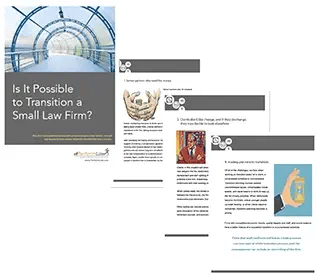Transitioning a law firm to the next generation of lawyers requires a deliberate approach and a sustained focus to be effective. This process is not just a one-time task but an ongoing commitment. It can be challenging for busy administrators and lawyers juggling daily business demands to give transition planning the attention it deserves. This is where outside support plays a crucial role in providing the necessary expertise and resources to complement internal efforts.
By involving management and staff in the planning process, a law firm can ensure that all stakeholders have a voice and a stake in the outcome. This collaborative approach helps in identifying common concerns, aligning priorities, and fostering a sense of ownership among team members. Additionally, seeking objective third-party advice can facilitate smoother communication and decision-making, especially when dealing with sensitive topics like partner transitions and equity buyouts.
A comprehensive transition planning process thoroughly analyzes various key areas such as work-life timelines, marketing strategies, attorney development, compensation structures, technology integration, and staff development. Each component plays a critical role in shaping the firm's future trajectory and ensuring a seamless transition of ownership and leadership.
Ultimately, the goal of transition planning is to develop a well-thought-out action plan that is ready for implementation. This requires careful consideration, strategic thinking, and proactively addressing challenges. By starting the planning process early and involving all relevant stakeholders, a law firm can navigate potential pitfalls and set itself up for long-term success.
Management and staff should be participants in the planning process since they have a stake in the outcome of the process. We have found that a firm’s management personnel often shares many of the concerns of younger partners, associates, and staff. Their awareness of the business continuity issues typically comes from their experience and direct input from the individual lawyers and other employees.
Objective third-party advice can enable a less risky communication process from not partner participants.
A typical transition planning process takes six months to a year to complete and involves an in-depth analysis of the following areas:
- Work-life timelines and capacity planning;
- Marketing and Business Development;
- Attorney development;
- Recruiting;
- Compensation and incentives;
- Transition and buyout compensation;
- Policy formulation;
- Partnership or operating agreement provisions;
- Orderly transfer of ownership interests;
- Financial Considerations;
- Technology;
- Platform building;
- Staff Development; and
- Implementation plan, schedule and process.
Taken together, these areas of concentration inform a firm’s highest priorities. The broad purpose of each analysis as follows:
- Work-Life timelines provide a planning horizon;
- Marketing effectiveness indicates the firm’s ability to meet revenue goals;
- Attorney development is essential to skill set continuity;
- Recruiting effectiveness enables a firm to address capability and capacity weaknesses;
- Compensation and incentives can attract high-profit laterals, ensure partners practice profitably, and incent senior partner transitions;
- Policy development is essential for promoting consistency and building trust among partners, associates and staff;
- A partnership or operating agreement ensures that necessary actions have the weight of a legal agreement;
- Perpetuating a law firm requires a process for transferring equity without controversy;
- Quantifying the potential impact the firm's profits and ultimately the income of the partners informs plan development;
- Technology can promote efficiency, provide a competitive advantage and bind clients to the firm;
- Creating a platform that elevates the success of the lawyers and staff builds value;
- A trained and motivated staff can support the knowledge transfer process; and
- Ensuring that process moves from planning to implementation is vital to the long-term interests of the firm.
The goal of the transition planning process is to develop a set of thoroughly analyzed and ready to implement action steps. We will review the various steps in detail in future blog posts.
DO YOU QUESTION IF
IT IS POSSIBLE TO TRANSITION A SMALL LAW FIRM?
This eBook Can Help
The only way to survive these challenges is to prepare for them and begin to address them now. This eBook describes some of these challenges and outlines ways to manage and overcome them. Most of all, the book calls out the importance to start the process NOW.
EBOOK:

.webp?width=124&height=108&name=PerformLaw_Logo_Experts3%20(1).webp)


